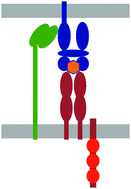Modulation of T-cell receptor functional sensitivity via the opposing actions of protein tyrosine kinases and phosphatases: a mathematical model
Abstract
Combining receptor kinetics and stochastic modelling of receptor activation, we show that a T-cell can specifically augment its functional sensitivity to one particular peptide ligand while simultaneously decreasing its sensitivity to other ligands, by coordinating the expression levels of the co-receptor CD8 and the relative activities of kinases and phosphatases in the vicinity of the T-cell receptor (TCR). We propose that this focusable degeneracy of epitope recognition allows a TCR to have a wide range of potential ligands but be specifically sensitive to only one or a few of these at any one time, which resolves the paradox of how a relatively small number of clones (∼106) can maintain the potential to respond to a vast space of ligands (∼209) whilst avoiding auto-immunity. We validate the model against experimental data and predict shifts in functional sensitivity following a shift in the kinase/phosphatase balance (which could in principle be induced by experimental means). Moreover, we propose that in vivo, the T-cell gauges ligand quality by monitoring changes in TCR triggering rate concomitant with shifts in this balance, for instance as the immunological synapse matures.


 Please wait while we load your content...
Please wait while we load your content...